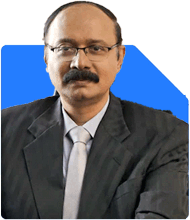Ramalingam Kalirajan |7915 Answers |Ask -Follow
Mutual Funds, Financial Planning Expert - Answered on Jun 17, 2024
He has an MBA in finance from the University of Madras and is a certified financial planner.
He is the director and chief financial planner at Holistic Investment, a Chennai-based firm that offers financial planning and wealth management advice.... more

Sir.. I am 34 years old having 2 girls age 3.5 and 3 months baby doing job in a private sector monthly income is 30 thousand for.. future which plan could be best for us..
Understanding Your Financial Goals
The first step in financial planning is to clearly define your goals. Your primary objectives likely include:
Providing for your daughters' education.
Ensuring financial security for your family.
Building a retirement corpus.
Managing day-to-day expenses efficiently.
Understanding and prioritizing these goals will guide your investment decisions.
Emergency Fund: The Foundation of Financial Security
An emergency fund is crucial. It should cover at least six months of your living expenses. This fund acts as a safety net during unexpected situations such as job loss, medical emergencies, or urgent repairs.
To build an emergency fund:
Start by setting aside a small portion of your income each month.
Keep this fund in a liquid, easily accessible account.
Gradually increase the amount until you reach your target.
Life Insurance: Protecting Your Family's Future
With young children, securing life insurance is paramount. Life insurance ensures that your family remains financially stable in case of your untimely demise.
When choosing life insurance:
Opt for a term plan with adequate coverage.
Avoid investment-cum-insurance policies as they offer limited benefits compared to term plans.
Ensure the coverage is at least 10-15 times your annual income.
Health Insurance: Safeguarding Against Medical Expenses
Health insurance protects against high medical costs. It is essential for your family’s financial health.
Consider the following when selecting health insurance:
Choose a comprehensive family floater plan that covers all members.
Look for policies with a high sum assured.
Ensure the plan covers critical illnesses and includes benefits like no-claim bonuses and preventive health check-ups.
Child Education Planning: Investing in Your Daughters’ Future
Education costs are rising, making early planning crucial. Investing in a child education plan helps in accumulating the necessary funds for their higher education.
Key points for child education planning:
Estimate the future cost of education, considering inflation.
Start investing early to benefit from compounding.
Use child-specific mutual funds or Public Provident Fund (PPF) for this purpose.
Retirement Planning: Ensuring a Comfortable Future
Retirement planning should begin as early as possible. This ensures a comfortable post-retirement life without financial worries.
Steps for effective retirement planning:
Determine your retirement age and lifestyle expectations.
Estimate the required retirement corpus, considering inflation.
Invest in retirement-focused mutual funds or Employee Provident Fund (EPF).
Mutual Fund Investments: A Balanced Approach
Mutual funds offer a balanced approach to investing, catering to various risk appetites and financial goals.
Consider these types of mutual funds:
Equity Funds: Suitable for long-term goals with higher returns but higher risk.
Debt Funds: Ideal for short to medium-term goals with moderate returns and lower risk.
Hybrid Funds: A mix of equity and debt, balancing risk and returns.
Systematic Investment Plan (SIP): Consistent Investing
SIPs are an excellent way to invest in mutual funds consistently. They offer the benefit of rupee cost averaging and disciplined investing.
Benefits of SIPs include:
Flexibility to invest small amounts regularly.
Mitigation of market volatility risks.
Encouraging a habit of regular saving and investing.
Regular Review and Rebalancing: Staying on Track
Regularly reviewing your financial plan ensures it remains aligned with your goals and market conditions. Rebalancing your portfolio periodically is essential to maintain the desired asset allocation.
Steps to review and rebalance:
Assess your portfolio’s performance annually.
Adjust investments to align with your risk tolerance and goals.
Seek professional advice if needed.
Avoiding Common Pitfalls: Staying Informed
Being aware of common financial mistakes can help you avoid them and stay on track with your financial goals.
Some pitfalls to avoid include:
Over-reliance on savings accounts for long-term goals.
Investing without adequate research or professional advice.
Ignoring inflation’s impact on future expenses.
Benefits of Actively Managed Funds
Actively managed funds involve professional fund managers who make investment decisions to outperform the market.
Advantages of actively managed funds:
Potential for higher returns through expert stock selection.
Flexibility to adapt to market changes.
Active risk management to protect your investments.
Disadvantages of Index Funds
Index funds aim to replicate market indices but come with certain drawbacks.
Limitations of index funds:
Lack of flexibility to react to market changes.
Potential underperformance in volatile markets.
Limited potential for higher returns compared to actively managed funds.
Importance of Professional Guidance
Seeking advice from a Certified Financial Planner (CFP) can significantly enhance your financial planning. A CFP provides personalized strategies based on your unique needs and goals.
Benefits of consulting a CFP:
Expert advice tailored to your financial situation.
Comprehensive planning covering all aspects of personal finance.
Regular monitoring and adjustments to your financial plan.
Regular Funds vs. Direct Funds
Direct funds might seem cost-effective, but they have certain disadvantages.
Drawbacks of direct funds:
Lack of professional guidance in fund selection.
Higher risk of making uninformed investment choices.
Regular funds offer the advantage of expert advice and support.
Setting Realistic Expectations
Setting realistic expectations is crucial for financial planning success. Understand that wealth building is a gradual process requiring patience and consistency.
Diversification: Spreading Your Risk
Diversification involves spreading investments across different asset classes to reduce risk. A diversified portfolio balances potential risks and returns effectively.
Building Financial Discipline
Financial discipline is essential for achieving your goals. This includes budgeting, saving regularly, and avoiding unnecessary debt.
Budgeting: The Cornerstone of Financial Planning
Creating and sticking to a budget ensures you live within your means while saving for future goals. Track your expenses and identify areas to cut back if needed.
Saving for Short-Term Goals
In addition to long-term goals, allocate funds for short-term needs like vacations, home repairs, or special occasions.
Teaching Financial Literacy to Your Children
As your daughters grow, teaching them about money management will prepare them for financial independence.
Preparing for Unforeseen Events
Ensure you have adequate insurance and an emergency fund to tackle unforeseen events without financial stress.
Regularly Updating Your Financial Plan
Life changes necessitate updates to your financial plan. Regularly review and adjust your plan to reflect changes in income, expenses, or goals.
Final Insights
Planning for your family's future requires a comprehensive approach covering all aspects of personal finance. From securing adequate insurance to investing wisely for education and retirement, each step plays a crucial role. Regularly reviewing and updating your plan ensures it remains relevant to your changing needs and circumstances.
By following these strategies and seeking guidance from a Certified Financial Planner, you can build a secure financial future for your family, ensuring your daughters' bright and prosperous future.
Best Regards,
K. Ramalingam, MBA, CFP,
Chief Financial Planner,
www.holisticinvestment.in
You may like to see similar questions and answers below
Ramalingam Kalirajan |7915 Answers |Ask -Follow
Mutual Funds, Financial Planning Expert - Answered on May 14, 2024
Ramalingam Kalirajan |7915 Answers |Ask -Follow
Mutual Funds, Financial Planning Expert - Answered on Jun 18, 2024
Ramalingam Kalirajan |7915 Answers |Ask -Follow
Mutual Funds, Financial Planning Expert - Answered on Jul 15, 2024
Anil Rego |384 Answers |Ask -Follow
Financial Planner - Answered on Jul 24, 2024
Moneywize |181 Answers |Ask -Follow
Financial Planner - Answered on Feb 08, 2025
Moneywize |181 Answers |Ask -Follow
Financial Planner - Answered on Feb 08, 2025
Dr Nagarajan Jsk |234 Answers |Ask -Follow
NEET, Medical, Pharmacy Careers - Answered on Feb 08, 2025
Moneywize |181 Answers |Ask -Follow
Financial Planner - Answered on Feb 08, 2025
Milind Vadjikar |989 Answers |Ask -Follow
Insurance, Stocks, MF, PF Expert - Answered on Feb 08, 2025
Ramalingam Kalirajan |7915 Answers |Ask -Follow
Mutual Funds, Financial Planning Expert - Answered on Feb 08, 2025
Ramalingam Kalirajan |7915 Answers |Ask -Follow
Mutual Funds, Financial Planning Expert - Answered on Feb 08, 2025
Dr Nagarajan Jsk |234 Answers |Ask -Follow
NEET, Medical, Pharmacy Careers - Answered on Feb 08, 2025
Dr Nagarajan Jsk |234 Answers |Ask -Follow
NEET, Medical, Pharmacy Careers - Answered on Feb 08, 2025
Ramalingam Kalirajan |7915 Answers |Ask -Follow
Mutual Funds, Financial Planning Expert - Answered on Feb 08, 2025






















